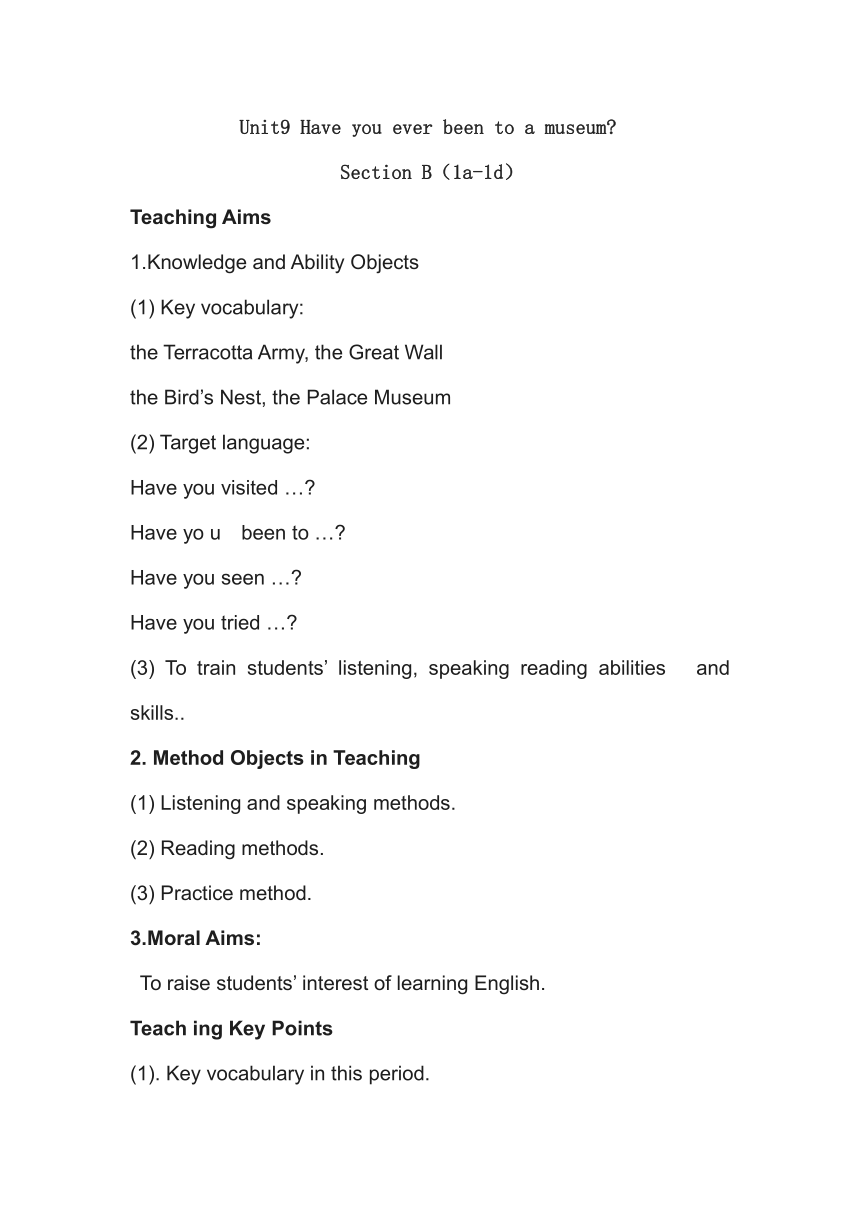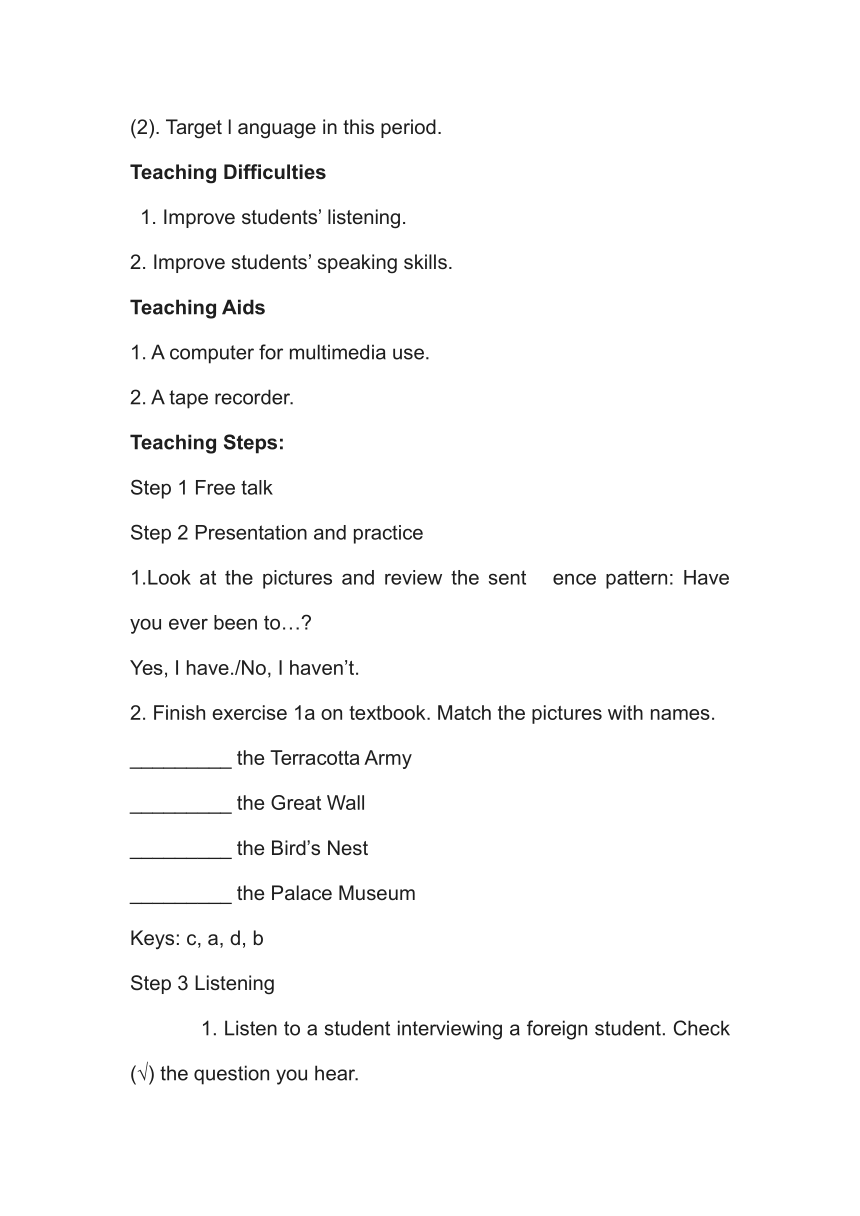人教版八年级下册 Unit 9 Have you ever been to a museum? Section B 1a-1d 教案
文档属性
| 名称 | 人教版八年级下册 Unit 9 Have you ever been to a museum? Section B 1a-1d 教案 |  | |
| 格式 | doc | ||
| 文件大小 | 23.5KB | ||
| 资源类型 | 教案 | ||
| 版本资源 | 人教新目标(Go for it)版 | ||
| 科目 | 英语 | ||
| 更新时间 | 2022-12-23 19:16:04 | ||
图片预览


文档简介
Unit9 Have you ever been to a museum
Section B(1a-1d)
Teaching Aims
1.Knowledge and Ability Objects
(1) Key vocabulary:
the Terracotta Army, the Great Wall
the Bird’s Nest, the Palace Museum
(2) Target language:
Have you visited …
Have yo u been to …
Have you seen …
Have you tried …
(3) To train students’ listening, speaking reading abilities and skills..
2. Method Objects in Teaching
(1) Listening and speaking methods.
(2) Reading methods.
(3) Practice method.
3.Moral Aims:
To raise students’ interest of learning English.
Teach ing Key Points
(1). Key vocabulary in this period.
(2). Target l anguage in this period.
Teaching Difficulties
1. Improve students’ listening.
2. Improve students’ speaking skills.
Teaching Aids
1. A computer for multimedia use.
2. A tape recorder.
Teaching Steps:
Step 1 Free talk
Step 2 Presentation and practice
1.Look at the pictures and review the sent ence pattern: Have you ever been to…
Yes, I have./No, I haven’t.
2. Finish exercise 1a on textbook. Match the pictures with names.
_________ the Terracotta Army
_________ the Great Wall
_________ the Bird’s Nest
_________ the Palace Museum
Keys: c, a, d, b
Step 3 Listening
1. Listen to a student interviewing a foreign student. Check (√) the question you hear.
_______ Have you visited the Palace Museum
_______ Have you been to the Great Wall
_______ Have you been to the Bird’s Nest
_______ Have you seen the Terracotta Army
_______ Have you tried Chinese food
Keys: 1,3, 5
2. Listen again and take notes.
Name: _____________________________________
Country: ___________________________________
How long in China ________________________
Places visited: ____________________________
Food: __________________________________
Keys: Peter, Australia, two weeks, the Palace Museum, the Great Wall, the Bird’s Nest, the Terracotta Army, Beijing Duck
3. Listen again and role_ play the conversation.
4. Retell the Peter’s story according to 1c.
Step 4 Role-play 1d
1.Work in pairs to ask your partner where she/he ha s been to
Have you visit ed …
Have you been to …
Have you seen …
Have you tried …
2.Show time: Act out their conversations.
3.Writing: C omplete their conversations.
Section B(1a-1d)
Teaching Aims
1.Knowledge and Ability Objects
(1) Key vocabulary:
the Terracotta Army, the Great Wall
the Bird’s Nest, the Palace Museum
(2) Target language:
Have you visited …
Have yo u been to …
Have you seen …
Have you tried …
(3) To train students’ listening, speaking reading abilities and skills..
2. Method Objects in Teaching
(1) Listening and speaking methods.
(2) Reading methods.
(3) Practice method.
3.Moral Aims:
To raise students’ interest of learning English.
Teach ing Key Points
(1). Key vocabulary in this period.
(2). Target l anguage in this period.
Teaching Difficulties
1. Improve students’ listening.
2. Improve students’ speaking skills.
Teaching Aids
1. A computer for multimedia use.
2. A tape recorder.
Teaching Steps:
Step 1 Free talk
Step 2 Presentation and practice
1.Look at the pictures and review the sent ence pattern: Have you ever been to…
Yes, I have./No, I haven’t.
2. Finish exercise 1a on textbook. Match the pictures with names.
_________ the Terracotta Army
_________ the Great Wall
_________ the Bird’s Nest
_________ the Palace Museum
Keys: c, a, d, b
Step 3 Listening
1. Listen to a student interviewing a foreign student. Check (√) the question you hear.
_______ Have you visited the Palace Museum
_______ Have you been to the Great Wall
_______ Have you been to the Bird’s Nest
_______ Have you seen the Terracotta Army
_______ Have you tried Chinese food
Keys: 1,3, 5
2. Listen again and take notes.
Name: _____________________________________
Country: ___________________________________
How long in China ________________________
Places visited: ____________________________
Food: __________________________________
Keys: Peter, Australia, two weeks, the Palace Museum, the Great Wall, the Bird’s Nest, the Terracotta Army, Beijing Duck
3. Listen again and role_ play the conversation.
4. Retell the Peter’s story according to 1c.
Step 4 Role-play 1d
1.Work in pairs to ask your partner where she/he ha s been to
Have you visit ed …
Have you been to …
Have you seen …
Have you tried …
2.Show time: Act out their conversations.
3.Writing: C omplete their conversations.
同课章节目录
- Unit 1 What's the matter?
- Section A
- Section B
- Unit 2 I'll help to clean up the city parks.
- Section A
- Section B
- Unit 3 Could you please clean your room?
- Section A
- Section B
- Unit 4 Why don't you talk to your parents?
- Section A
- Section B
- Unit 5 What were you doing when the rainstorm came
- Section A
- Section B
- Review of Units 1-5
- Unit 6 An old man tried to move the mountains.
- Section A
- Section B
- Unit 7 What's the highest mountain in the world?
- Section A
- Section B
- Unit 8 Have you read Treasure Island yet?
- Section A
- Section B
- Unit 9 Have you ever been to a museum?
- Section A
- Section B
- Unit 10 I've had this bike for three years.
- Section A
- Section B
